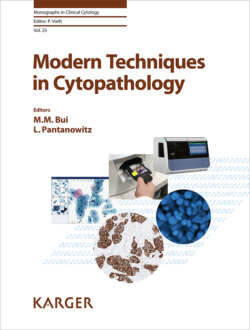Читать книгу Modern Techniques in Cytopathology - Группа авторов - Страница 11
На сайте Литреса книга снята с продажи.
US-Cytology Correlation
ОглавлениеThe “triple-test” concept in breast FNA is not new to cytopathologists. Physical examination, imaging, and cytology findings all need to be taken into account for clinical guidance. Cytologist USFNA is an expansion of the “triple test” concept. Much can be learned about a mass to be sampled from its US characteristics: mass shape, margins, echogenicity, blood flow pattern, presence or absence of posterior acoustic shadowing, and characteristics of echogenic foci.
US features of a mass impart a degree of “relative risk” which can be classified as favor benign, indeterminate, or suspicious for malignancy. The categorization of a mass based on US findings closely parallels what pathologists are already very familiar with based on experience with gross and microscopic pathology. Correlation of US images and cytology findings is of utmost importance. If the US findings are suspicious for malignancy but the cytology is benign, the cytologist needs to determine whether there is a sampling problem or why the US and cytology do not correlate. In the case of benign-appearing US features and malignant cytology, the same correlation needs to be done. For example, a well circumscribed mildly hypoechoic breast mass with posterior enhancement could be classified as favor benign or indeterminate by US criteria, but is a mucinous carcinoma by cytology; the cytologist knows that the results correlate. The cytologist is in the perfect position to understand why these processes have their particular US characteristics. With experience, the cytologist can even begin to predict what cytology will show based on the US features of the lesion. Radiologists, even with the availability of ROSE, do not get to so closely correlate US findings and cytology findings.
